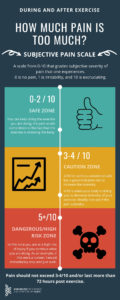Opening hours
Monday-Friday 7am-7pm
< Back to all blog articles
When Is Too Much? Subjective Pain Scale
By Physiotherapist, Paulina Backiel
When is too much? How much can my body handle?
When you go to the physio, you might think, “why on earth are they asking me an endless amount of questions?” If only answering these questions could get you points to win money like in the game of “Who wants to be a Millionaire” – am I right?
Well, the reason that physiotherapists do this is that each individual is different. There may be similar patterns that we find with each injury we see, but there will always be that slight difference in everyone’s journey and recovery.
The human body is amazing, it can heal itself or adapt to anything that life throws at it. But just like us, it can fall into the wrong habits and adapt to improper use of muscles or loading.
Let’s take running as an example.
Your body will have an idea about the proper mechanics of running which we all learnt as children. The only thing is, if you have been working at a desk job that makes you sit for 8+ hours a day, there could be a possibility that you may not have gone for a run for quite some time. Regardless, you still get up and run and to your surprise, it feels absolutely great (well that was easy). Now you’re getting to the last kilometre of your run, and whilst you’re thinking “I used to run 5km so I should be able to do it now right?”, your calves get super tight and your knee begins to feel a bit niggly.
Sound familiar?
This is a great example of how your body has the capability to keep you upright. However, it does come down to two things:
1. BIOMECHANICS: the mechanism your body is using that is causing the knee pain is not right
2. THRESHOLD: the calf muscles are not used to having that much load put on them.
SUBJECTIVE PAIN SCALE
Below is the pain scale that I introduce to all my patients on how to stay safe whilst exercising.
 It is scaled out of 10, where 0 indicates no pain, 1 would be a mild irritation, and 10 being excruciating pain.
It is scaled out of 10, where 0 indicates no pain, 1 would be a mild irritation, and 10 being excruciating pain.
0-2 / 10 | SAFE ZONE
You can keep doing the exercise you are doing, the pain would come down to the fact that the exercise is stressing the body.
3-4 / 10 | CAUTION ZONE
3/10 for some is still considered safe but a good indication not to increase the intensity of your exercise.
4/10 is when your body is telling you to decrease intensity of your exercise. Modify it to see if the pain subsides.
5+ / 10 | DANGER/HIGH RISK ZONE
In this zone you are at a high risk of injury if you continue what you are doing. As an example, if this were a runner, I would immediately stop and just walk.
So guys, stay safe and keep exercising 🙂
If you feel like you may have injured yourself or you are in pain, click HERE to book in with one of our practitioners now!
Related Articles
22
May
May
Winter Sports – Pain Management Advice for Musculoskeletal Injuries
Winter is a period that brings with it a different set of obstacles relating to musculoskeletal injuries. Engaging in winter sports or activities in colder temperatures can increase the risk of injury. However proactive pain management st...
18
May
May
Exercise and Mental Health – Lifting Weights to Lift Your Mood
One of the overlooked benefits of exercise is its impact on mental health and wellbeing. Alongside the physical benefits, exercise has been proven to improve mood, stress, sleep and energy levels; as well as reduce the incidence and sever...
13
Apr
Apr
Rest Days Are The Best Days – Why Resting Is Just as Important as Going Hard
Did you know that April only has one week with 5 working days? Are you taking full advantage of that opportunity to regain some control over your schedule? Are you trying to fit too much into your public holiday and not maximising the time?...